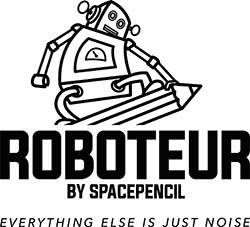Robotic process automation (RPA) is quickly becoming the must-have tech solution for companies across the board – and resellers are finding novel ways to provide their customers with bot solutions.
Bots are proving their value in performing tedious or repetitive processes, doing them accurately, 24/7 and without complaint.
Until now, each process within each company has employed a new and unique bot. While there are many compelling advantages to RPA, this model and the costs involved have often made the employment of bots for low-value processes prohibitive.
SpacePencil developed its Roboteur system specifically to address the problem of cost versus benefit, helping companies to build much more cost-effective bots that enable them to automate processes that would be deemed unviable by the more complex and expensive tools on the market
And now the company has found a way to further reduce the cost of employing bots by enabling a bot software as a service (SaaS) model.
 Brian Little, chief operating officer of SpacePencil, explains that this is a natural progression for the software development company.
Brian Little, chief operating officer of SpacePencil, explains that this is a natural progression for the software development company.
“In a typical development, the service provider partners would implement Roboteur as a standalone product, creating a bespoke framework in which to build an end user application. So if the customer wants to automate things, they can build their own apps for their own workflow.
“There are also a number of standard bots that can be plugged into the workflow. The increasingly present use of cloud based software applications makes this a very real SaaS model opportunity,” Little adds.
This model works well for service providers who supply their own specialty solutions or services. “Within these solutions there are many opportunities for automation, where they can create bots for processes that are usually done manually, but are standard functions.”
Little cites the example of accounting software users. “There is a big community of customers who all use the same accounting package. And they all have to reconcile their accounts to the bank statement – this function could be automated with a bot and the service provided by a SaaS partner to any number of businesses requiring the service.
“But most small businesses don’t reconcile their bank statement every day, and it certainly doesn’t take all day to do it. So why shouldn’t a service provider build a bot that reconciles the bank within a particular accounting package and let many customers use that bot as a service?”
In this case, the partner is not reselling Roboteur, but rather providing a service built on the Roboteur platform.
“There are many different SaaS models kicking around the industry today,” Little points out. “From the start, we built Roboteur to help partners reduce complexity, and we have always aimed to keep complexity out of our product and pricing models.
“But looking at the available SaaS solutions, we found more complexity. We wanted a much simpler model, so we developed our own. Basically, we don’t care how the reseller bills his customers – by the minute, by the solution, by number of users – we simply ask for a percentage of that. And we cap that percentage in a way that both encourages the SaaS partner to offer more services to customers to a point where we do not take a ‘royalty’ beyond the cap.
“We’ve also made the cost and management of multiple bots for the same service provider much more transparent – and attractive,” he adds.
Inevitably, a partner selling services would require more than one bot. “To help them develop this business, within the model of the Roboteur franchise, we are willing to let the SaaS provider have a cluster of bots upfront,” Little explains. “We would execute a low fixed charge, typically that of a single bot, but provide a significant bot cluster number to them, depending on how they execute the shared infrastructure model.”
“This allows them to run parallel processes, running the bots as a swarm to increase their processing power. By the time they are using 80% of the bot cluster capacity, we would start charging per bot above, for example, the initial cluster of 10 bots again where applicable. Such a cluster would in itself deliver significant bot availability to the partner and their customers.”
“The benefit for the partner is that there is minimal upfront cost, so no buy-in price. This is in complete contrast to other RPA vendors where the buy-in costs can be exorbitant.”
Swarming – or running several bots in parallel – is a new technology solution that SpacePencil has pioneered.
“This is the ability to have multiple bots acting together, with almost linear scalability,” Little explains.
Most organisations experience spikes in demand at various times of the day or month, depending on what process is running. When this happens, they have the ability to employ more bots on that process so they can pass more transactions through the system.
“So they can either have one bot working away for five hours, or five bots doing the same job in one hour,” says Little. “And they can spin these swarms up or down on the fly, employing them only for the period required.
“This particular ability would be particularly useful in the SaaS environment, and allow service providers to offer services with confidence, knowing they will be able to fulfil them within their SLAs.
“Our SaaS model itself is offered with our SLA to the provider as part of the package giving them piece of mind around being able to report and escalate any issues encountered within the structures of our SLA,” Little adds
“We continue to offer our Professional Services to both VAR and SaaS model Partners where we can either build RPA bit solutions for them to offer their services or even simply build bespoke software for them or their customers using our Z1 Low code Development Framework with its rapid development and deployment ability.”
Technology in action
AI Dynamics uses Roboteur RPA to deliver software services to its customers.
MD Jon Randall explains that the company has a strong cybersecurity focus. “We use technology to do the heavy lifting for us, employing bots to process the massive amounts of data in various operational systems that need to be analysed.”
RPA is perfectly suited to this job, he adds. “It allows us to provide customers with a tool that takes away what would otherwise have been a substantial human resource requirement.”
AI Dynamics has partnered with SpacePencil and the Roboteur as its RPA technology of choice for a number of reasons, Randall says.
“They are a great company to deal with, and we have had a good experience working with them. The technology suits our needs. The team has always been very responsive in ironing out any issues or adding features and enhancements to improve how we use the solution.”
Perhaps most importantly, the Roboteur solution does exactly what is required, at a much lower cost of ownership than many other RPA systems on the market.
“This means we can provide our customers with bots to process huge amounts of data from various systems and present it for analysis much quicker – and more accurately – than a human could do it. And using bots is a lot more cost-effective than developing bespoke systems or tools to perform the same function.”
Get the power of the swarm
Swarming is a way of managing a group of robots as a team.
 That’s the high-level explanation of how the technology works from Barry Buck, SpacePencil’s chief technology officer and creator of Roboteur.
That’s the high-level explanation of how the technology works from Barry Buck, SpacePencil’s chief technology officer and creator of Roboteur.
“Swarming delegates work for robots to perform in parallel, and reconciles the tasks when they are complete,” he explains. “So if you have 10 000 records to process and 10 robots available, swarming allows you to divide the records up so each robot processes 1 000 records – and the job is completed in one-tenth of the time.
“This gives users a lot of additional throughput for jobs that are time-sensitive.”
The swarming technology can also determine which bots are best suited to the job at hand, and will allocate jobs on the fly according to suitability and availability, Buck adds.
“For the administrator, he can treat a fleet of robots as one robot, managing the full fleet as they would a single bot.”
The power of the swarm can be increased as bots are added, and so administrators can grow their processing power as they need it.
Customers would use swarming when they require high volumes of transactions to be processed, but want to reduce the time it would take for a single bot to perform. Swarming also helps with availability during times of high transaction throughout.
“Swarming is particularly useful in the context of software as a service (SaaS),” Buck says. “With headless bots on something like a Linux server, service providers can dynamically spin up bots as needed to perform tasks like document processing, web automation or logic – basically anything that doesn’t require a user interface.
“We believe this will be especially useful for SaaS suppliers, who can now supply bots as needed at a relatively low cost.”
Roboteur swarming will be available by the end of the fourth quarter of 2022.

